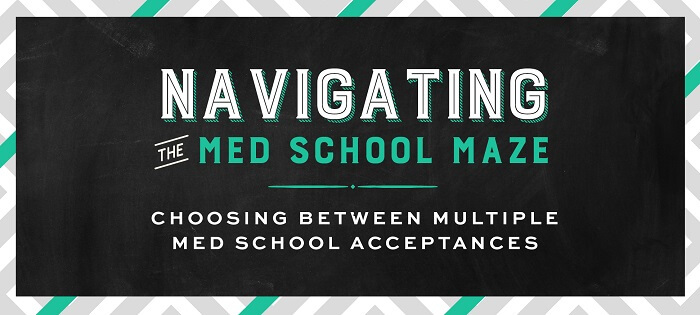Choosing Between Multiple Medical School Acceptances
You’ve taken the MCAT, completed all the pre-reqs, and maybe shadowed a physician, done some research, and volunteered. Now it’s time to make sure you’re all in for the last legs of this long journey. In this series, we’ll discuss how you can continue to navigate your way to a med school acceptance by analyzing your profile, creating a strong med school application, writing stellar AMCAS and secondary essays, and nailing your interview.
It’s the time of year when med schools are finalizing their classes after a long admissions process, and sending much-anticipated acceptance letters. I genuinely hope one of those letters found or is about to find its way to your mailbox and give you the joy of shrieking at the top of your lungs and running through the halls of your science building screaming, “I’M GONNA BE A DOCTOR!!!” I believe everyone should feel that feeling about something in life.
After the excitement has worn off, if you’ve been accepted to multiple institutions, you’ll need to make a decision about where you’ll actually attend.
Here are some stats:
• According to the AAMC, the 2016 application cycle showed 830,016 applications from 53,042 applicants, making an average of 16 applications per applicant.
• Of that gaggle of paperwork, 21,030 matriculated to medical school.
• HOWEVER, we all know schools also pull from their waitlist because students choose other schools or defer for a year, etc.
• To get a snapshot of just how many acceptances schools offer above their class size, let’s look at the 10 most selective programs: Mayo, Stanford, Georgetown, Wake Forest, Florida State, George Washington, UCLA, UC Davis, Brown and UC San Diego. Together, they boasted an average acceptance rate of 2.57% and took in an average 9,122 apps for an average of 128 seats. Take the average acceptance rate of the average number of apps, and you get 234 seats, close to double their average class size.
So what does all of this mean? It means that even the pickiest schools are offering many more acceptances than they have seats for because students are getting multiple acceptances on a consistent basis. This past year, East Tennessee’s College of Medicine offered a total of 124 acceptances for 72 spots.
To help you narrow down your multiple acceptances to “the ONE,” ask yourself the following questions (broken down into two categories: logical, and emotional).
Logical questions:
1. Which school can you afford?
Loans add up, and as a medical student, you’ll qualify for $42,722 in Unsubsidized Loans through the government that accumulate interest at 5.31%. The rest must be made up through Graduate Plus Loans, which are at 6.31%, as well as scholarships, which are hard to come by in med school.
2. How far is family or a support system?
When you do get breaks (which is not often), you may want to spend your time with family. Medical school is hard, and not having family within driving distance (say, six hours or less) would make breaks more stressful than they need to be. Plane tickets add up as well, and you may not have a lot of extra cash lying around.
3. Does the city have what you need to satisfy all your needs?
When you get out of class after a Friday exam, do you want to go hiking in the mountains or clubbing for the weekend? Choosing an area that has your interests is extremely important, because doing something you want to do to decompress is as important as having a favorite study place.
4. What do current students say?
Word of mouth is still the most powerful tool in marketing, and medical schools are no different. Contact the admissions committee and ask if you can set up a phone or Skype conversation to talk with a current student, and really get their perspective of being at that school.
Emotional questions:
1. How was your interview day at each school?
Interview day is pretty indicative of how the school operates on a daily basis, and if you got rubbed the wrong way by some M1s or M2s, chances are you’ll still not get along with them next fall. Also, how well did you like the admissions people? That’s who the school has chosen to represent them, and you’ll be dealing with them for the next four years with everything from your loans to potlucks/fundraisers and finding a trustworthy place to fix your car in town.
2. How big are classes?
Do you want an intimate family-like environment or do you prefer the autonomy of a few hundred students?
3. Do you have a significant other to consider?
There’s an old saying that goes, “Happy wife, happy life,” and choosing a school where your significant other can be happy is as important as you being happy. Take into consideration the job market for them in the area of each school and cost of living if you’re looking into buying a house.
4. What does your gut say?
Your instinct is a reflection of an accumulation of life experiences that help you weigh decisions as the potential of good or bad outcomes. Trust this experience and this feeling when choosing a school, and you won’t be led astray.
Sometimes it helps to hear about other people’s dilemmas and decisions. We’ve interviewed hundreds of med school applicants and students from around the world – read their stories on our blog today!
[xyz-ihs snippet=”Navigating-Med-Maze”]
This is a repost of an article by Joshua Wienczkowski. For more articles by Joshua, check out our popular series Journeys with Joshua.
Related Resources:
• Navigate the Med Maze, a free guide
• How to Defer a Medical School Acceptance
• Admissions Straight Talk Podcast


